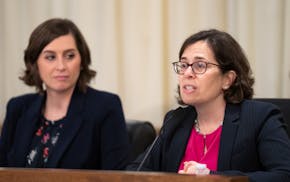Opinion editor's note: Star Tribune Opinion publishes a mix of national and local commentaries online and in print each day. To contribute, click here.
•••
Those mostly red, blue-blotched maps of Minnesota you saw on this newspaper's pages and website last week did more than report election results. They also depicted a sharply divided people.
What did the 2022 election tell us about ourselves, Minnesotans? That map shows it: The trials of the past four years have made this state's red places redder and blue ones bluer. Our partisanship has deepened, remarkably and maybe even dangerously so.
What that tells me is that even though DFLers will hold all the reins in the State Capitol next year for only the second time since 1990, governing this state will be anything but easy. Gov. Tim Walz and the House and Senate's spare DFL majorities are bound to encounter strong resistance from Republicans who maintain — with justification — that they are simply representing their districts.
By the vote-tote numbers, Walz's win last week might be deemed a lot like his first gubernatorial victory four years ago. He garnered about 80,000 fewer votes, out of 2.5 million votes cast, than he did in 2018 — a relatively small change.
The map and the numbers that accompany it reveal more. They show that instead of carrying 21 of Minnesota's 87 counties, as he did in 2018, Walz won only 13.
Two of those were whopping wins. Walz scored 72% of the vote in Ramsey County and 70% in the big prize, Hennepin. Both were gains over his 2018 performance. His share of the vote compared with 2018 also grew in Dakota, Washington, Olmsted and Cook counties.
Dakota, Washington and Olmsted counties used to be Republican strongholds. They turned purple a decade ago. Now, with the exception of a few long-serving Republican legislators, they are almost-reliable DFL territory.
A contrary pattern prevailed in the rest of Minnesota. In county after county, Republican challenger Scott Jensen outperformed his 2018 counterpart, Jeff Johnson.
That was true even in counties that are home to vibrant regional centers and plenty of government employees. For example: Kandiyohi (Willmar) saw the GOP share of the gubernatorial vote grow from 56 to 62%. In Nobles (Worthington), it went from 54 to 66%. In Stearns (St. Cloud — an "ouch" for the DFL), from 56 to 60%.
Blue got bluer, red got redder. Lots of Minnesotans — not just professional worriers like me — don't like that trend, especially because it cuts along rural/urban lines.
In lots of states, city and country citizens think and vote differently. Minnesota has become one of them. In so doing, Minnesota risks becoming a more ordinary state, not the place with better-than-average prosperity and well-being that it has become in the past half-century.
Much of Minnesota's modern success can be traced to its citizens' willingness to aggregate their resources via progressive taxation and share them in ways that benefit the whole state. That's the essence of the government finance system that Minnesota built in the mid-20th century. It's a system that relies heavily on a functional state government and a sense of shared purpose and destiny among Minnesotans, regardless of party.
Regional quarrels that lead to mistrust and hostility threaten that system. So do party politics that call on loyalists to serve their faction or region rather than the whole state.
On some level, I think, even Minnesotans who aren't fixated on government get that. Voters seemed to be begging for more unity four years ago, when they elected as governor a congressman from Mankato whose campaign theme was "One Minnesota."
Walz was still intoning those words this year. Fewer people in greater Minnesota were buying it. Republicans will say that's the fault of governing decisions made by Walz and the DFLers who dominate metro Minnesota in the past four years.
I won't absolve Walz & Co. for a share of blame for a more divided Minnesota. But there's a lot more going on here. Big demographic and economic trends and divide-and-conquer power-seekers on the national and world stages have done much to drive a deeper wedge between metro and non-metro Americans. Much of that is out of a governor's control.
What's not is what Walz does in the next four years to counter those trends. He can choose to make a more concerted and consistent effort to sell Minnesotans on the advantages that lie ahead for them if they stick together. He can choose to travel more, meet more and listen more to people throughout the state.
He can work harder to build genuine friendships with Republicans in the Legislature and with DFLers who were once his intraparty rivals. Minnesota's best governors made such relationships a priority.
Policies will matter too, of course. But as Walz likely learned through the last four tough years, gubernatorial leadership involves much more than sending policy proposals to the Legislature. He will serve well in a second term if he makes clearer each day that for this state to thrive, "One Minnesota" must be more than a campaign slogan.
Lori Sturdevant is a retired Star Tribune editorial writer. She is at lsturdevant@startribune.com.

Olson's cheers and jeers: When OLA speaks, it's best we listen
Opinion: The unjust detention of Doğukan Günaydın
Dabney: This 420 is going to be lit

